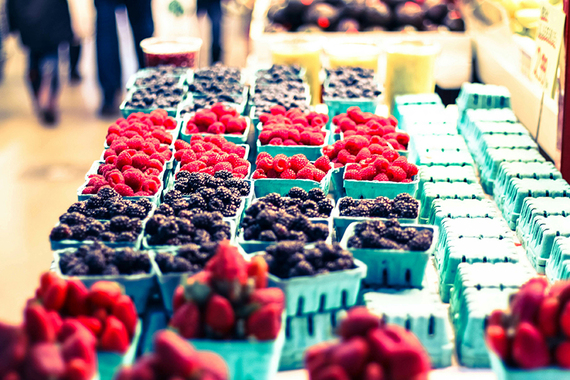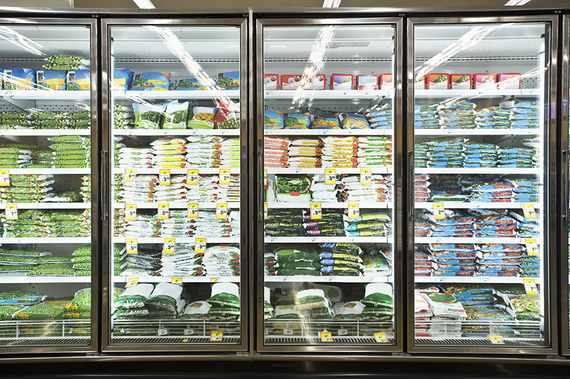Step 1: Shop with a plan.
For SELF, by Audrey Bruno.
Healthy eating starts with choosing the right ingredients--it's way easier to make a nutritious meal if your kitchen is already stocked with amazing seasonal produce, affordable proteins, and healthy whole grains. But when you're grocery shopping it's pretty easy to get distracted by convenient frozen meals and delicious looking pre-packaged sweets. Especially when a mountain of chocolate bars and candy is waiting for you at the checkout line.
Eating healthy means something different to everyone, and it doesn't have to mean you can't enjoy indulgent snacks and desserts. But if you're looking to lose weight or make better diet choices, you might want to have a few healthy food shopping tricks up your sleeve for when you head to the grocery store. Registered dietitians shared eight excellent tips that will help optimize all your shopping trips from now on. Turns out, it's pretty easy to fill your cart with the best and brightest ingredients if you know exactly what you're looking for and just where to find it.
1. Always make a shopping list.
Going to the store with a plan is key, explains Emily Cope-Kyle, M.S., R.D.. This will help keep you from buying things you don't need or want, especially if you're perusing aisles with pre-packaged and processed foods. Using a list as your guide will help save you time AND money.
By now you probably know exactly where your local grocery store keeps the sweets. If you're watching your sugar intake, or you're prone to impulse buys, Amy Gorin, M.S., R.D., owner of Amy Gorin Nutrition, suggests steering clear of these sections while shopping. "I have a huge sweet tooth so I try and walk past the bakery and candy section," she says. As the saying (sort of) goes, out of sight, out of stomach. Many experts recommend shopping only the perimeter of the store as that's where the freshest food tends to be displayed. And when you're ready to kick things up a notch, try organizing your grocery list by where the foods are located in the store. Efficient and healthy--it's a win-win.
3. Shop at multiple stores.
"The beauty of shopping at two stores [is that] you can likely always find what you need," says Cope-Kyle. If your local grocery store is running low on fresh produce, check out another store or even swing by the farmer's market. If you're lucky, you may even discover something healthy and delicious that you would have never found before.
For fruits and veggies, I love following the seasonal items," says Maxine Yeung, M.S., R.D., owner of The Wellness Whisk, "They are usually at their peak and you can get a large amount for much less than when they are out of season," which means they're cheaper AND they taste better. Even better? Most foods can keep in the freezer for months at a time. So stockpiling and freezing seasonal produce will ensure you're using the best ingredients all year long. Yeung likes to load up on fresh berries during the summer and use them in desserts and smoothies.
You're not always going to be able to find the fresh produce you need (sometimes it just isn't strawberry season)! In these situations, frozen and canned fruits and vegetables are perfectly acceptable alternatives. Gorin recommends choosing frozen produce when possible, but notes that with fruits and vegetables that retain more water (like tomatoes), you can opt for the canned version instead. One major tip: Always look for cans that say no salt added.
6. Buy produce that will last longer.
Gorin likes to invest in ingredients like onions and garlic, which tend to stay fresher longer. "I also buy bananas on the greener side so they last," she says. You could do the same with avocados, tomatoes, and other unripe produce, she explains.
7. Try shopping like a vegetarian.
Protein aids muscle recovery and will help keep you feeling satiated. And, overall, vegetarian proteins (like tofu and tempeh) can sometimes be more affordable than meat-based options. So if you're on a budget and want to load up on the macronutrient, Gorin suggests shopping like an herbivore, even if you aren't about that meatless life. That doesn't mean you can't splurge on a beautiful steak or chicken from time to time, but it will help keep the contents of your cart more affordable most of the time.
8. Buy raw nuts and seeds in bulk.
Yeung likes to stock up on raw nuts and seeds, which are easy to add to meals and snack mixes. If you don't feel like making your own snack mixes, Gorin recommends looking for prepackaged snacks with lots of healthy fats and protein. She likes Wonderful Pistachios 100-calorie packs and KIND fruit and nut bars. And always be sure to check the nutrition label, because certain items that advertise themselves as healthy may be packed with added sugars and preservatives.



